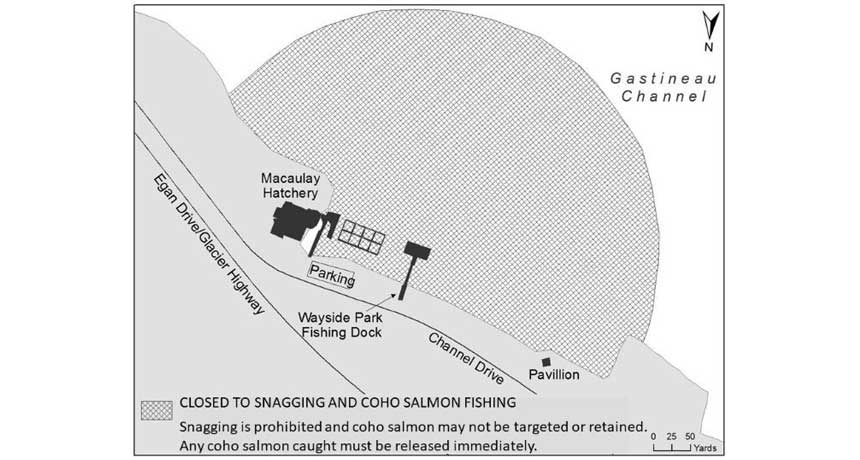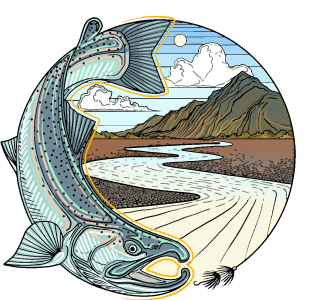It has been a tough week for coho fishing and the next few days aren't looking a whole lot better. A big slug of rain is descending on us and our already high and muddy creeks and beaches will be getting slammed again. The coho fishing was picking up nicely around the weekend of August 20th, but then it dropped off over the weekend of the 27th. Poor water conditions certainly weren't helping, but we could all tell the numbers were just not there. We have been getting a lot of questions at the shop about why the coho run has been so different from the last 6 or 7 years.
To help provide a little clarity, here is a brief summary of events that led up to this season. Our local coho fishery is made up of two distinct stocks of fish: hatchery fish released by DIPAC and wild fish that return to local rivers. Wild fish are typically associated with Montana Creek and Cowee Creek as well as some small runs in other local rivers. With a few minor exceptions, coho caught in Gastineau Channel are of hatchery origin. If you fish Sheep Creek, Thane, Bayview, 9 Mile & 5 Mile North Douglas or anywhere in Gastineau Channel you are fishing DIPAC hatchery coho. The original brood stock for these coho came from a tributary of the Taku River that produces unusually large coho. This is why so many coho at Sheep Creek are so big!
When the coho return to DIPAC, they take the eggs to rear the next generation of fish. The eggs are taken and fertilized in the fall, they then hatch and are called "pre-smolts" and then they are held for another full year so when the smolts are released they are 1 1/2 years old. You may remember that in December of 2020 Juneau and the surrounding areas had one of the worst storms we've seen in years. We got over 4 inches of rain in a very short time along with high winds which caused flooding and some very large landslides. One landslide was in the Salmon Creek watershed which is where DIPAC gets its water supply. This landslide cut their water line and left them without enough water to keep all their salmon fry alive. Using city water wasn't an option since our drinking water has a small amount of chlorine in it which is lethal to baby salmon. Right in the middle of winter DIPAC had to release 80% of their coho smolt into the saltwater. Ideally these smolt would have been held until the following spring when they were larger and there would be more food available for them. In all likelihood, these fish did not survive.

Salmon Creek landslide from the December of 2020.
In the spring of 2021, DIPAC was only able to release 200,000 smolt. In a typical year the smolt release number would have been closer to 1,000,000. These 2021 smolts are the fish that are returning as adults this year. Because of the small number, they were all released at DIPAC's facility near Salmon Creek. Typically, net pens are towed to the Sheep Creek area and the young coho imprint on Sheep Creek water and when they return they linger around Sheep Creek for 3-4 weeks before eventually going to the hatchery. Without this happening in 2021 we knew there would be little to no return to Sheep Creek this fall. But we were counting on a still respectable 12,000 fish returning to the channel. (For comparison there were approximately 43,000 coho that returned to the channel during the banner season of 2021). Coho ocean survival can vary greatly, so we hoped the 12,000 number might have even been a little better, but it is now looking like ocean survival was unusually poor. Both wild and hatchery coho seem to have had a low survival rate this last year.

Due to low initial returns the area around DIPAC has been closed to fishing so they can get the brood stock needed for the next generation.
DIPAC needs 350 pair of salmon (700 fish total) to ensure the next generation of salmon. In order to get these fish back to the hatchery they have closed the area in front of the hatchery to fishing and snagging.
We often track the Golden North Salmon Derby to get an idea of coho abundance in the Juneau area. The derby is the 2nd weekend in August so it happens right before coho get ready to hit our local beaches. This year's derby fishing for coho was really tough which was an early sign that the run might be small.
So where do things go from here? Keep in mind that it is still early September. Both the pink salmon and chum salmon were late to arrive this year, so we may see a moderate push of fish a bit later than usual. While it won't be a large run, there still will be fish returning. Anglers who stick it out and fish September consistently will find some coho here and there. We all need to readjust our expectations from "limiting out" to hitting the water during the weather breaks, enjoying the fall season, and being happy when we pick up a fish. The weather looks like it will settle down towards the middle of next week and give our local streams and beaches a chance to clear up. We will keep our eye on the fishing and update you during next Thursday's report.
Stay dry Juneau! Brad, Mike, Cory, Rocky, Finley & Gage






Mike
Thanks for all the help while we were in Juneau. We did manage to get coho Monday between Bayview and 9 mile. Each fish was on the falling tide when a group of fish pushed through the channel on there way back out.to sea Did not see a lot of fish caught. Both fish on a home tied black and chartruese articulated fly with no flash.
Brett Wilson